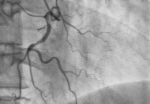A lesion ≥50% in the left main coronary artery (LMCA) is considered severe, according to various scientific societies, regardless of the presence of symptoms or ischemia, due to the extent of myocardium at risk. In such cases, revascularization is indicated. In many patients, lesions in this section of the coronary artery have severe calcification, which...
What Is the Prognosis of an Acute Myocardial Infarction in the Presence of Moderate Aortic Stenosis?
Aortic stenosis (AS) is a common condition that shares risk factors with coronary artery disease. Many patients can suffer from both diseases simultaneously, something that increases the risk of acute myocardial infarction in the presence of aortic stenosis. AS can cause ischemia even in the absence of coronary artery disease, due to ventricular hypertrophy, increased...
TAVR Durability at 5 Years in Intermediate Risk Patients
TAVR has been shown beneficial in patients across the risk spectrum. The PARTNER 2 SAPIEN 3 (P2S3i) study on intermediate risk patients was the first to show TAVR superiority vs SAVR when using the transfemoral approach. SAVR durability has been shown in different analysis but, except for a few reports, TAVR durability at long term...
Is Edge-to-Edge Treatment with PASCAL Effective at 3 Years?
Mitral regurgitation is the most common valvular heart disease. Its cause is most frequently functional or secondary dysfunction (functional mitral regurgitation, FMR) compared with degenerative mitral regurgitation (DMR), which is associated with decreased ventricular function, hospitalization for heart failure, and mortality. While medical treatment is effective over extended periods, a significant number of patients cannot...
Clinical Results of IVUS-Guided Drug-Eluting Stent Implantation in Femoropopliteal Disease
Endovascular treatment of femoropopliteal lesions has become the first-line treatment due to the development of devices that decrease the restenosis rate. Recently, the IMPERIAL study showed greater patency at 1 year and greater freedom from clinically guided revascularization at 2 years in favor of the ELUVIA stent (paclitaxel-eluting fluoropolymer, FP-DES) compared with the ZILVER PTX...
Transfemoral vs Transradial Approach in the Percutaneous Treatment of CTO
Percutaneous treatment of chronic total occlusion (CTO) has traditionally been via the transfemoral approach (TFA). The use of the transradial approach (TRA) in complex coronary interventions has been increasing. A randomized study assessed the use of TRA vs TFA in complex PCI (58% CTO) and TRA saw favorable outcomes. The aim of this prospective, randomized,...
Regional Course of Interventionism for the Clinical Cardiologist | with SOLACI’s Support
On November 30, 2019, the “I Regional Course of Interventionism for the Clinical Cardiologist” will take place in Chiclayo, Peru. The event will be held in the Muchick Room at Costa del Sol Hotel, organized by the Peruvian Society of Hemodynamics and Endovascular Interventionism (SOPHIE) with the support of SOLACI. The activity will be oriented to...
Subintimal vs. Intraplaque Coronary Rechanneling. Do Results Vary?
Coronary rechanneling is difficult by nature, and there are several techniques for it aimed at improving technical success. Some of these strategies entail the subintimal crossing of the occluded segment, while others entail intraplaque crossing, without leaving the true lumen. However, there is scarce or no information on the results of both strategies. Researchers analyzed...
Balancing Bleeding Risk vs. Thrombotic Risk to Define Dual Antiplatelet Therapy Duration
Patients who undergo complex angioplasty are at higher ischemic risk, but only benefit from extended dual antiplatelet therapy if there are no factors for high bleeding risk. These data suggest that the bleeding risk must weigh more than the ischemic risk on the determination of dual antiplatelet therapy duration. Complex angioplasty is associated with higher...
Surveillance after EVAR: When and How Long
It has been suggested that surveillance after endovascular abdominal aorta aneurysm repair (EVAR) should be for life, seeing as on one hand we are not sure how long these devices last (and they keep coming out), and on the other hand, there could be late complications, such as type 2 leaks. This is why the...









